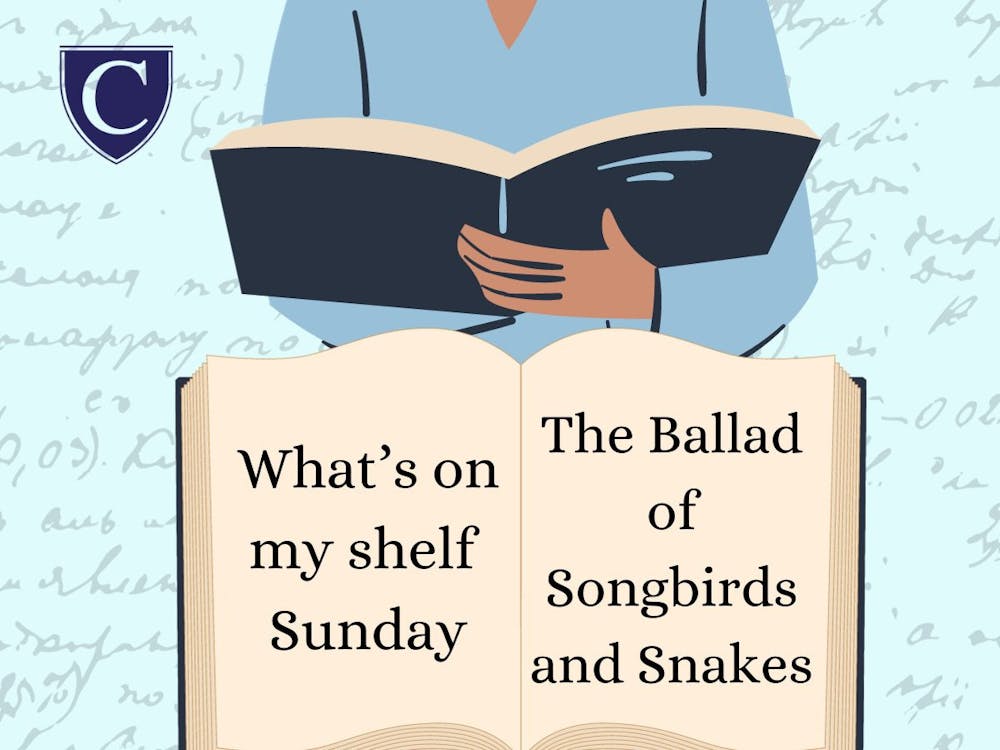With the long-awaited release of the movie, it felt timely to write a review of “The Ballad of Songbirds and Snakes,” Suzanne Collins’ 2020 prequel to “The Hunger Games.” The novel chronicles Coriolanus Snow, later President Snow in the original trilogy, as he becomes a mentor in the 10th annual Hunger Games.
For those unfamiliar with the plot of “The Hunger Games,” the Capitol – a city of politicians and wealthy families in a dystopian North America called Panem – controls the 12 Districts and their food supply. In order for Capitol citizens to maintain order, they host the Hunger Games each year, forcing two children from every district to fight to the death in a Capitol-constructed arena.
When the novel begins, Coriolanus struggles to reconcile his family’s loss of status in the wake of the war brought on by the Capitol’s attempt to stifle a district revolt. Since both of his parents died in the war, Coriolanus and his cousin, Tigris, live with their grandmother, whom Tigris has nicknamed “the Grandma’am.” The three of them are the last living members of the once-respected Snow family.
When Coriolanus wakes up the morning of Reaping Day – the day tributes from each district are chosen to compete in the Games – he has to force down salted cabbage and hope his shabby clothes will not reveal his family’s impending bankruptcy.
From the first chapter, Collins introduces themes of wealth and privilege, which grow more complicated as the novel progresses. Coriolanus’ preoccupation with his own struggles blinds him to the condition of the Districts, a fact that is reinforced by the lyrics of the Capitol anthem that he hears his grandmother singing from the other room:
Gem of Panem,
Seat of power,
Strength in peacetime, shield in strife.
Protect our land
With armored hand,
Our Capitol, our life!
This anthem, which the Grandma’am recites each morning, subliminally promotes the sort of violent patriotism that the Academy teaches Capitol students like Coriolanus every day. The Academy becomes one of the principle settings in the novel, as 24 of its promising students are assigned a District tribute to mentor in the Games.
Enjoy what you're reading?
Signup for our newsletter
When it comes time for the televised reaping ceremonies, Coriolanus feels slighted at being assigned the female tribute from District 12, typically the first to die in the arena. His disappointment vanishes, however, when a girl around his age gets chosen. As the live footage being broadcasted to the Academy pans to Lucy Gray Baird, her brown curls and worn rainbow dress draw the Capitol’s interest. She promises to be trouble in the games when she slips a venomous snake down the back of another girl’s dress while making her way through the crowd and then captivates the audience by singing a ballad on the reaping stage.
While the rest of the mentors remain largely uninterested in winning the trust of their tributes, Coriolanus meets Lucy Gray at the Capitol train station with flowers. She repays his efforts by preventing the other tributes from attacking him, and the two are bonded from then on.
Despite Coriolanus’ immediate connection to Lucy Gray, he struggles to understand that she and her fellow tributes are human beings. He does not bat an eye when these district children are housed in a zoo cage leading up to the games or at the fact that they are treated by a veterinarian whenever they need medical attention.
One of the other mentors, Sejanus Plinth, foils Coriolanus’ lack of empathy. Sejanus’ family moved to the Capitol from District 2 when he was young, and he abhors the cruelty of the games. Throughout the book, Sejanus keeps the Capitol atrocities in perspective, even though Coriolanus often ignores his opinions.
Like the initial trilogy, Collins’ “The Ballad of Songbirds and Snakes” combines fast pacing with strategy, making for an entertaining read. While “The Hunger Games” clued me in to Coriolanus’ fate, I spent most of the prequel wondering what would lead to the protagonist’s transformation into the heartless President Snow. For these reasons – and my wary fascination with the protagonist’s budding affection for Lucy Gray – I stayed invested in the plot throughout.
With that being said, I found the symbolism overdone. The constant allusions to the tributes as animals lacked subtlety, and much of Sejanus’ dialogue challenging the norms of the Capitol felt repetitive. In my opinion, the obvious fact that the games are wrong didn’t need to be repeated.
Recurring moments of moral questioning make the tone of the novel fit a younger age group than intended. As a result, “The Hunger Games” reads as though it is targeted at an older demographic than “The Ballad of Songbirds and Snakes.” Plus, the characters were often unlikable and underdeveloped compared to those in the trilogy.
All this aside, I’m looking forward to seeing how the film adaptation portrays Coriolanus’ story.
Rating: ★★★.5
Content warning: accounts of inhumane treatment, graphic descriptions of death and murder
Support independent student media
You can make a tax-deductible donation by clicking the button below, which takes you to our secure PayPal account. The page is set up to receive contributions in whatever amount you designate. We look forward to using the money we raise to further our mission of providing honest and accurate information to students, faculty, staff, alumni and others in the general public.
Donate Now



